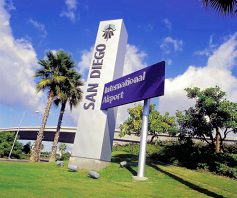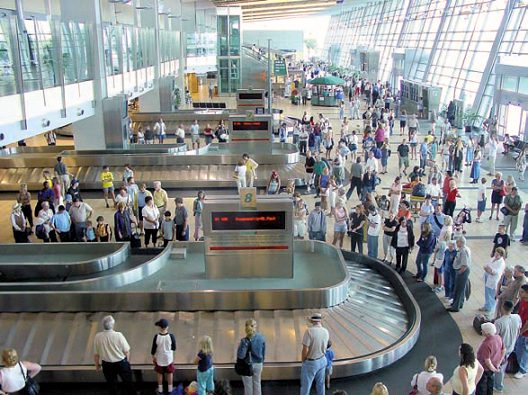 Typical airport master plans provide conceptual structure for future growth and improvements, with an emphasis on physical infrastructure like buildings and runways. The San Diego County Regional Airport Authority is taking a more progressive approach by supplementing the master plan for San Diego International Airport (SAN) with a companion information technology (IT) master plan.
Typical airport master plans provide conceptual structure for future growth and improvements, with an emphasis on physical infrastructure like buildings and runways. The San Diego County Regional Airport Authority is taking a more progressive approach by supplementing the master plan for San Diego International Airport (SAN) with a companion information technology (IT) master plan.
SAN’s five-year IT master plan, developed by Jacobs Engineering Group, lays out the information technology that will be needed to maximize the benefits of improved and expanded infrastructure, in terms of enhanced customer service and return on investment.
After assessing existing conditions at SAN, Jacobs interviewed employees, airlines, passengers, vendors and other key stakeholders who use the airport to determine how their airport experiences could be improved. “On the basis of what we learn from these interviews and our knowledge of IT and where the technology is headed, we identify what we’ll need in terms of IT capabilities to get the airport from here to where it should be any given time in the future,” says Jacobs’ Information Systems vice president, Enrique Melendez.
Jacobs subcontracted with The Solution Design Group and Convergent Strategies Consulting to provide specialized IT services in support of the master planni
|
Facts and Figures Project: Information Technology Master Plan Location: San Diego International Airport Owner: San Diego County Regional Airport Authority Primary Consultant: Jacobs Engineering Group Cost: $1.1 million Completion Time: Approximately one year Sub-consultants: The Solution Design Group and Convergent Strategies Consulting AVI/RFID Vendor: TransCore Potential Revenue Opportunities: Shared infrastructure The Need: Support major capital improvements, improve customer service and maximize the use of infrastructure |
SAN’s IT director, Howard Kourik, is passionate about grabbing every advantage advanced IT can offer. “The IT master plan establishes the framework for SAN to consistently anticipate, accommodate and exceed the expectations of the Authority,” Kourik says. “As IT director, it’s my goal to help the airport be technologically competitive in a constrained economic environment.” Consistent with Kourik’s goal, key components of the IT master plan include implementing CUPPS – common-use passenger processing services, and developing shared tenant resources.
Maximizing Resources
Jacobs identified CUPPS as a way to save money and maximize the 650 acres SAN has to accommodate all of the airport’s operations. “With the CUPPS model, the airport owns the infrastructure that the airlines use through lease agreements. Two or three airlines can use the same ticket counter, gate or passenger holding area at different times. This flexibility allows more efficient use of infrastructure,” explains Melendez.
Consultants consequently have to consider the airport facilities as a single system. “Anything we do to change the capacity or efficiency of one part can affect the capacity or efficiency of another,” says Melendez. The effect can be an opportunity or a limitation.
|
SAN’s five-year IT master plan, developed by Jacobs Engineering Group, lays out the information technology that will be needed to maximize the benefits of improved and expanded infrastructure, in terms of enhanced customer service and return on investment. |
To avoid straining the capacity of any of the airport’s facilities, The Solution Design Group developed a model to identify the existing facility limitations. “Our model considered the relationships among the various terminal facilities,” he explains. “For example, adding an additional aircraft at certain times of the day could overload the security checkpoints, which cannot be expanded in the existing terminal facility.”
The Solution Design Group also studied the airport’s back office operations, business systems and the AVI (automatic vehicle identification system) and recommended a potential revenue opportunity.
At SAN, commercial ground transportation vehicles such as buses, taxis and courtesy shuttles are equipped with battery-operated AVI transponders furnished and installed by the airport. The transponders monitor the vehicles to ensure that they stick to the commercial traffic lane to ease congestion in the passenger loading zone.
The Solution Design Group recommended that the airport use RFID (radio frequency identification) stickers instead, because they don’t require batteries and are less costly than traditional transponders. In addition, The Solution Design Group recommended that the airport use the system to charge trip tolls and use the stickers to track the amount of time vehicles spend in the commercial vehicle lane to support traffic management and airport security efforts.
Convergent Strategies’ contributions to the IT master plan included recommendations that will align the latest technologies with the airport’s overall business needs. It recommended that the airport change to a voice-over internet protocol (VoIP) telephony system and configuration so SAN could provide voice services to its tenants. “Pooling resources and using existing internal network infrastructure would save overall communications costs,” says Jim Willis, principal consultant for Convergent Strategies. “There’s an added advantage in terms of service, because the owner of the communications system, the Authority, is on site and can respond to service calls more quickly than an off-site provider is able to.”

Applying the CUPPS business case, SAN IT master planners had to be sure the effects of increasing the number of aircraft turns at the gates didn’t impact other passenger processing facilities, such as ticket counters, security checkpoints, passenger hold rooms and baggage carousels.
Convergent Strategies also evaluated SAN’s flight information display system. “If we have a common-use system, where resources such as airline gates are shared, then we need to make sure that the information displayed to the traveling public is continuously updated,” notes Willis. “That means that we need to ensure that the various systems used to control gate assignments, check-in and passenger boarding (CUPPS), and display the arrival/departure information need to be integrated.”
Focus on the Future
The SAN IT master plan is noteworthy not only for its breadth, but also because it addresses sustainability. “SAN is one of the first major airports to adopt a formal sustainability policy, and sustainability is a significant element of both the Airport master plan and the IT master plan,” says Melendez. “We’ve made technology recommendations that consume the least amount of power and generate the least amount of waste. We’ll make use of existing infrastructure to the extent possible and recyclable materials will be used in construction.”
LCDs, for instance, were proposed for public information displays because they have low power requirements and don’t produce excess heat.
In addition to environmental advantages, cost savings and possible revenue streams, Kourik anticipates benefits on many levels. “Integrating IT into airport master planning helps prepare us technologically for the future. In short, customer service will just keep getting better,” he notes.



